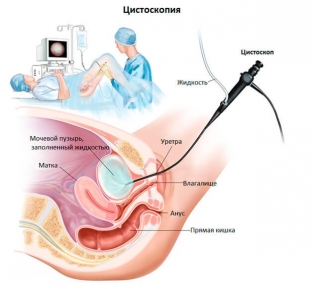Cystoscopy is an endoscopic examination of the bladder, which is performed using a special optical system to visualize the bladder cavity. Cystoscopy is the "gold standard" in the diagnosis of many urological diseases, and does not have the same informative similar diagnostic methods. In addition, in some situations, cystoscopy can also serve as an effective therapeutic method. Unfortunately, in most patients, the word "cystoscopy" causes undisguised fear, and they refuse to perform a much-needed procedure. Therefore, sufficient knowledge of the doctor in the issue of cystoscopy and full awareness of the patient, taking into account all the rules of medical ethics and deontology, is the key to the successful management of a urological patient.
The main types and principles of the structure of cystoscopes
There are two types of cystoscopes used in modern urology - rigid and flexible cystoscopes. With the help of a rigid cystoscope, the doctor can directly see the state of the bladder through the optical system of the cystoscope with his own eyes. The flexible cystoscope is equipped with an optical system that displays the image on the screen. Rigid cystoscopes are used much less frequently today, because, in addition to causing pain to the patient during cystoscopy, they do not have the ability to visualize the condition of the bladder as accurately as a flexible cystoscope can. The principle of the structure of a cystoscope is quite simple: it is a catheter that is equipped with an optical system.
Indications for cystoscopy: in what cases is the method used
Suspicion of bladder pathology is in itself an indication for cystoscopy, since there is no method that would provide information about the condition of the bladder to the same extent as cystoscopy. But, given the morbidity of the procedure and the existing minimal likelihood of trauma to the bladder, there are strict indications for cystoscopy.
- Suspicion of cancer of the bladder or urethra.
Cystoscopy makes it possible not only to clarify the location of the process, the volume and nature of the lesion, but also provides an opportunity to carry out a biopsy of the altered area during the examination for histological examination and confirmation of the diagnosis, which, in turn, will help to choose the most effective treatment regimen.
- Traumatization of the bladder.
Similarly to a malignant process, cystoscopy can be used to clarify the size and extent of damage.
- Hematuria (excretion of blood in the urine).
Cystoscopy is the only method that can absolutely identify the source of bleeding in the bladder, or confirm bleeding from the upper urinary tract.
- Presence of stones or foreign objects in the bladder.
In this case, cystoscopy plays the role of a therapeutic method, because with the help of a cystoscope it is possible not only to determine the characteristics of the calculus, but, in most cases, to remove it from the bladder cavity.
- Insufficient effectiveness of other diagnostic methods.
In such a situation, cystoscopy is used when there are no direct indications for its implementation, but it is not possible to establish a final diagnosis using other diagnostic methods.
Contraindications for cystoscopy: when the method is prohibited
There are local and general contraindications for cystoscopy. Local contraindications include an acute period of inflammation of the bladder or urethra, due to the likelihood of minimal trauma to the mucous membranes of the urethra and bladder during the cystoscope, which can aggravate the course of the disease.
General contraindications include conditions such as pregnancy, due to the close proximity of the walls of the bladder to the walls of the uterus, as well as the presence of renal and hepatic insufficiency and decompensated pathology of the cardiovascular system, since cystoscopy can worsen the general condition of such patients.

Method of performance and sequence of cystoscopy
The cystoscopy procedure should only be performed by a qualified urologist. The patient is placed on a couch or gynecological chair, with legs wide apart and bent at the knees. The doctor or nurse treats the external genital organs, since the sterility of the cystoscope and the treated field excludes the possibility of infection in the bladder. After that, the doctor inserts into the urethra that end of the cystoscope, which is equipped with lighting and optical systems, and examines the bladder cavity. The duration of the procedure depends, first of all, on the proposed diagnosis and the goals for which cystoscopy is performed. In general, the examination of the bladder cavity takes no more than 10 minutes.
The main methods of pain relief during cystoscopy
The most valuable method of preventing the occurrence of pain during cystoscopy is the normalization of the patient's emotional state. The doctor must provide the patient with all the information about the methodology and technique of the procedure, which he owns. When the patient understands what will happen to him during cystoscopy, he will not worry and be afraid of the unknown, he will not focus on minimal discomfort. Often, such preparation is quite enough to ensure that the patient does not have unpleasant memories and fear of a second procedure. In the process of cystoscopy, the doctor uses a special cathegel preparation, which improves the conduction of the cystoscope, and produces a sufficient analgesic effect. If therapeutic measures or a biopsy are to be performed, it makes sense to use painkillers such as fentanyl and propafol in individually calculated doses. In this case, during the cystoscopy, the presence of an anesthesiologist is necessary. After the procedure, pain medication may be recommended to the patient to eliminate pain that may occur several hours after the cystoscopy.






Add a comment